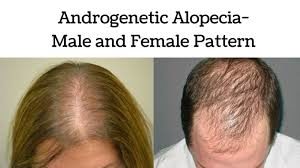Not only the older people but also younger people get affected by androgenic alopecia(pattern baldness). In this context, it will be interesting to have a look at the statistical reviews. According to case studies, androgenic alopecia causes hair loss in most of the cases, and that fifty percent of men and fifteen percent of women are susceptible to lose hair, on account of androgenic alopecia. The disease which is also known as the male or female pattern baldness is genetic in nature. It runs in the family, and so, if any one of your family members has been affected by androgenic alopecia, you stand the chance of inheriting it.

What causes androgenic alopecia?
As you know, that hair follicles need congenial conditions for growth and development, but in androgenic alopecia, the presence of excess androgen or male hormone serves as an impediment to the growth and development of the hair follicles. It is the concentration of androgen that poses as an obstacle. Women who are in their menopause have little or no female hormones, and so, at this stage, when the concentration of androgen is more, they are likely to be affected by the androgenic alopecia.
Symptoms associated with this disease
The most common symptom is thinning of hair. Symptoms are not similar in males and females. Men affected by androgenic alopecia tend to lose hair around the crown. Sometimes, the temple gets also affected. The hairline in general, tends to recede, as a result of which, baldness develops. On the other hand, in women, the head’s topmost part tends to get affected. Men stand the chance of getting bald, but androgenic alopecia doesn’t cause baldness in women. The crown in addition to the head’s topmost part gets affected in females.
The therapeutic options
Androgenic alopecia cannot be prevented, but with the therapeutic procedures, it is possible to stop hair loss and boost the growth of hair follicles. FDA approves the usage and application of minoxidil, a medication, which can be topically applied. It is not yet known how the composition acts, but as per the case studies, the medication boosts the supply of blood to the hair follicles. It also lengthens the phase of anagen and thereby stops androgen from causing havoc. Minoxidil which can be applied by both males, as well as females, should be used on a regular basis, at least for four months. That’s because discontinuation marks the return of the balding pattern.
Some of the other medications
If small parts particularly, the space around the vertex have been affected by androgenic alopecia, the patient is likely to gain from the application of minoxidil. Another medication, by the name of finasteride also diminishes the symptoms of the male pattern baldness. The drug which is to be administered orally is not suitable for treating female pattern baldness. That’s because finasteride has the potential to cause serious congenital defects including ambiguous genitalia. But the drug stimulates hair growth in males. Females affected by androgenic alopecia are often treated with compositions that suppress the secretion of androgens. Spironolactone is one such composition that is administered to females who have been losing hair, on account of the excess secretion of testosterone. Some of the patients have also been found responding to Dutasteride which is supposed to be thrice as powerful as finasteride.
